How to Survive the Demographic Cliff and the Spending Wave
Economics / Demographics Jan 15, 2014 - 05:36 PM GMTBy: John_Mauldin
 For today's Outside the Box, my longtime friend Harry Dent is letting us have a look at chapter 1 of his latest (and I would say his greatest) book, The Demographic Cliff: How to Survive and Prosper During the Great Deflation of 2014-2019. Harry's grasp of the impact of demographics on economies and investments is unexcelled and unambiguous. We all know that demographics really matter, but Harry has looked deeper and harder and understood better than any of us.
For today's Outside the Box, my longtime friend Harry Dent is letting us have a look at chapter 1 of his latest (and I would say his greatest) book, The Demographic Cliff: How to Survive and Prosper During the Great Deflation of 2014-2019. Harry's grasp of the impact of demographics on economies and investments is unexcelled and unambiguous. We all know that demographics really matter, but Harry has looked deeper and harder and understood better than any of us.
One of the key insights Harry brings to us is the concept of the Spending Wave. In other words, it's not just when you and the rest of your generation were born that matters, it's when you spend. At what age does your spending peak for housing or for child rearing or travel? Harry and his team have developed really good numbers on all of this, and from that data they have been able to consistently predict major macroeconomic trends. Harry summarizes the recent decades and the coming ones like this:
The demographic climaxes in average peak spending led to the rising boom from 1983 to 2007, then the slowdown in 2008 that will carry on until 2020 until trends bottom out and 2023 before trends turn up again. These numbers won't predict stock crashes and swings in the markets in between, but the big picture is undeniable.
There is a lot more to Harry's thesis than we can fit in an Outside the Box – chapter 1 alone runs 35 pages, and I can only bring you the first 10 here. So to help you bring Harry's work into immediate focus – and because I always like to compare notes with Harry – I recently asked him to sit down with me and talk over what we can expect to see in 2014. Some interesting ideas emerged at the intersection among demographics, debt, and deflation – three of the "Killer D's" that were my topic in last week's Thoughts from the Frontline – and we also looked at potential great trades for the coming year.
Our conversation, moderated by Mauldin Economics publisher Ed D'Agostino, is available right here.
I write this note from the airport lounge in Riyadh, Saudi Arabia, at the beginning of a long 24 hours to get back to Dallas. Riyadh was a fascinating exclamation point on my foray into the Middle East. When visiting a new country or region, I try to arrive with as few expectations as possible … and then absorb.
I have to say that my hosts, the MASIC group, treated me as well and as with as much genuine hospitality as anyone has done in any of the 60+ countries I have visited over the years. Sometimes that can be person-specific, and certainly the family that owns MASIC spent a lot of personal time taking care of me and the other speakers; but I also observed here how people in general are treated, and I found myself appreciating a tradition of hospitality that I had heard a lot about but never had the opportunity to experience first-hand.
Oddly enough – and I have to admit this observation was a bit outside the scope of my expectations – I found a good deal of similarity between a nation with a “country” Bedouin cultural heritage and the cowboy culture and mythos I grew up with in West Texas. The differences are also apparent and were somewhat jarring at times, but somehow the overall sense of the people was strangely familiar. These are people who, once they are your friends, treat you with a deeply felt sense of honor and acceptance. Where I grew up in Texas, the meaning and value of a handshake was drummed into me at an early age. I think a handshake might have value here as well. Just my impression.
I have a great fascination with Japan and the Japanese culture, but I am not sure I will ever understand it very well, except perhaps in an intellectual sort of way. Here, I got the sense that the gulf of personal understanding was not as wide. Big differences in style, yes. But then the world thinks all Texans wear cowboy hats and boots.
The MASIC group that invited me is an old Saudi business that has grown quite large, yet the family is clearly quite involved and is dealing with many of the very same issues that large family firms in the US confront. And is dealing with them more openly than many.
I'm afraid I often learn a lot more from the people I meet on these trips than I impart to them. On this occasion I laughed a lot more than usual – and had some quite serious conversations as well.
The entire Middle East is in the midst of great change, in a world that is changing even faster. I am forcibly reminded on trips like these that the world is simply unprepared for the rapidity and scale of change that is going to happen over the next 20 years. The jobs we will have in 20 years will be quite different from the ones we have today. Think 1850 to 1950 in the US – but compressed into one lifetime.
And yet I was asked some of the right questions during my stay here, which is more than I experience on many trips. All too often, we humans we want to figure out how to protect ourselves from unwanted change rather than trying to make the change work for us.
British Airways is calling my flight, so it is time to hit the send button. Among other little problems, their seat ate my brand new iPad on the trip out here, so my plan to sit and read on the return flight to London has gone by the wayside. Sigh. I look forward to being on American from London and having wifi for nine hours. Maybe I can catch up a little with my email inbox.
I will write this week’s letter from Tampa, as I have to make a quick trip there to meet with some medical research teams, along with my friend and colleague Patrick Cox. There are fascinating discoveries being made, and I have an opportunity to talk with a newly forming group that is working on the types of changes we all want. What a fascinating world I have stumbled into, where I seem to have a front-row seat to watch all sorts of stupendous changes unfold. Have a great week.
Your once again running to the gate analyst,
John Mauldin, Editor
Outside the Box
subscribers@mauldineconomics.com
The Demographic Cliff Around the World
By Harry Dent
(An excerpt from chapter 1 of The Demographic Cliff: How to Survive and Prosper During the Great Deflation of 2014-2019)
One simple indicator warned of the crashes in Japan from late 1989 forward and in the United States in 2008. It's called the Spending Wave.
The wave is not a function of stock valuations, but of consumer spending patterns over the course of their life cycle. It's about the predictable things people do as they age.
Demographics tell us a typical household spends the most money when the head of the household is age forty‐six—when, on average, the parents see their kids leaving the nest. Reading these numbers is no different from life insurance actuaries predicting when the average person will die and, based on that, making projections decades ahead.
Essential to understanding broad economic trends is the recognition that new generations of consumers enter the workforce around age twenty and spend more money as they raise their families, buy houses and cars, borrow, and so on. You may peak at a different age, likely in your early fifties if you are more affluent and went to school longer (as your kids probably did or will, too). The demographic climaxes in average peak spending led to the rising boom from 1983 to 2007, then the slowdown in 2008 that will carry on until 2020 until trends bottom out and 2023 before trends turn up again. These numbers won't predict stock crashes and swings in the markets in between, but the big picture is undeniable.
In 1989, stocks in Japan peaked dramatically at 38,957 on the Nikkei. A major real estate peak followed in 1991. Despite unprecedented monetary stimulus since 1997 (there's that QE—quantitative easing—again), more than two decades later stocks remained down 80 percent in late 2012. Likewise, twenty‐two years later, real estate is still down 60 percent from the peak, and commercial real estate by even more. Real estate has never bounced back significantly, even though, from 1999 forward, a new— but significantly smaller—generation began to reach the right age to buy houses.
Did you know that almost all of the money spent on housing occurs between ages twenty‐seven and forty‐one? In Our Power to Predict in 1989, I predicted Japan would see a twelve‐to‐fourteen‐year downturn, while the United States and Europe would see their strongest decade in history. Only demographic indicators could anticipate such a powerful shift in the global economy.
After two lost decades in a coma economy, in early 2013 the Japanese government announced that it would implement the most aggressive stimulus program in history to turn things around. Stocks advanced dramatically in response into mid‐2013, but we can't know for how long, given that the advance is based on a desperate monetary policy meant to fight dire debt ratios and demographic trends. Since Japan's first demographic slowdown was over in 2003, why wasn't the last decade more prosperous?
The world's economists simply have not come to terms with not only what happens when the largest generation in history reaches its spending peak, but also what it means when that generation is followed by a smaller one. We need to consider hard questions, such as what happens when Japan, most of the countries in Europe, the North American countries, and even China face shrinking workforces and reduced population growth. And what happens as more people retire than are entering the workforce? How does that affect economic growth and commercial real estate? What happens when more homes go onto the market as people die than there are younger buyers to buy them? Such a situation has not occurred before in modern history, and it will have a powerful effect on economics. We've seen it already in Japan, which I will cover in chapter 2.
The Best Leading Indicator
The best indicator? People do predictable things as they age. That's it in a nutshell. So, let's look at how demographics drive economic trends, from the macro to the micro, in modern middle‐class economies.
Only since 1980 have we had clear and detailed annual surveys from the U.S. government on how consumers spend, borrow, and invest over their life cycle, down to very small sectors (remember my reference to potato chips? Sales of those peak at age forty‐two for the average household). But with great volumes of such data, it is possible to forecast the most fundamental economic trends.
Consider that the Consumer Expenditure Survey (CE) from the U.S. Bureau of Labor Statistics measures more than six hundred categories of spending by age—and spending really changes in different areas according to age. The average family borrows the most when the parents are age forty-one, typically the time of their largest home purchase. They spend the most at age forty‐six, although more affluent households reach that peak later, between age fifty‐one (top 10 percent) and fifty‐three to fifty‐four (top 1 percent). People save the most at age fifty‐four and have the highest net worth at age sixty‐four (and later for more affluent households). Predictably, as we live longer these peaks slowly move up in age. The Bob Hope generation, born in increasing numbers from around 1897 to 1924, reached their spending peak at age forty‐four in 1968, meaning their boom was a forty-four‐year lag on the birth index from 1942 to 1968.
The average person enters the workforce at age twenty, an average of those who complete their education with a high school degree at age eighteen and those who graduate from college at age twenty‐two. Typical Baby Boom couples got married at age twenty‐six (though that age is rising, presently hovering around twenty‐seven‐plus). That's when apartment rentals peak, too, and the average kid arrives when his or her parents are ages twenty‐eight to twenty‐nine. That stimulates the first home purchase at about age thirty‐one—as soon as people can afford it! As the kids first become teenagers, parents buy their largest house, between ages thirty‐seven and forty‐one. (Why? Parents and kids both need more space in this difficult period of adolescence. You want the kids to be way over there and you way over here—and the kids agree!) We continue to furnish our houses, and thus spending on furniture overall peaks around age forty‐six, which, again, is also the peak in spending for the average household.
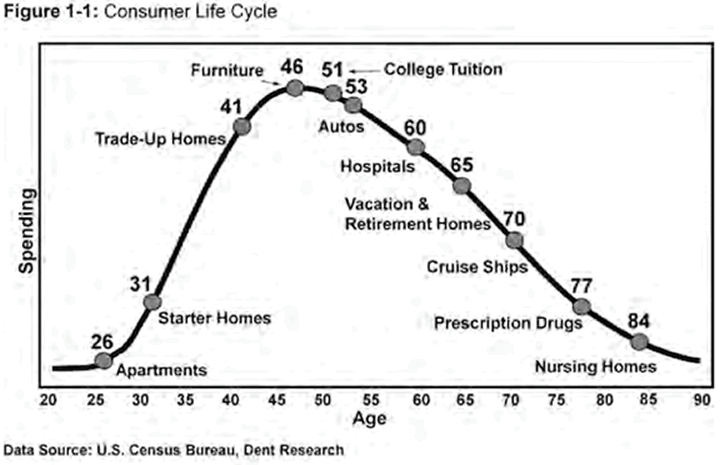
A sample of some key areas of consumer spending out of the broad survey. Does this resemble your life pattern? If not, it's likely because you are more affluent and peak a bit later in these areas.
In the downward phase of spending, some sectors continue to grow and peak. College tuition peaks around age fifty‐one. Automobiles are the last major durable good to peak (that's around age fifty‐three), as parents buy their best luxury car after the kids have left the nest and they don't need a boring minivan anymore. Some get fancy sports cars. Some get big pickup trucks. These are in fact the sectors doing the best in 2013 before they peak after 2014. But then their vehicles last much longer as they have nowhere to drive without the kids, so car spending plummets thereafter.
Savings rise most from age forty‐six to fifty‐four and continue to grow, though more slowly, toward a net worth that peaks at age sixty‐four, one year after the average person retires at age sixty‐three. Spending on hospitals and doctors peaks between age fifty‐eight and sixty. Vacation and retirement home purchases peak around age sixty‐five. People travel more from age forty‐six to sixty, after their kids leave the nest, but then they begin to find it too stressful. They finally choose to just go on cruise ships and be stuffed with food and booze with no jet lag or customs hassles. That peaks around age seventy. Then there are the peak years for prescription drugs (age seventy‐seven) and nursing homes (age eighty‐four).
I have highlighted only some key areas: the data can tell you much more, such as when consumers spend the most on camping equipment, babysitting, or life insurance.
The peak in overall spending in Figure 1‐2 is at age forty‐six and revolves around kids' getting out of school and the need for spending dropping for parents so that they can both enjoy life more and save for retirement. Spending on furniture peaks here as well. But note that there is a plateau between age thirty‐nine, when home buying starts to peak, and age fifty-three, when auto spending peaks. Then spending drops like a rock all the way into death! This is a big deal that governments, businesses, and investors are not anticipating as the massive Baby Boom generation ages in one country after the next.
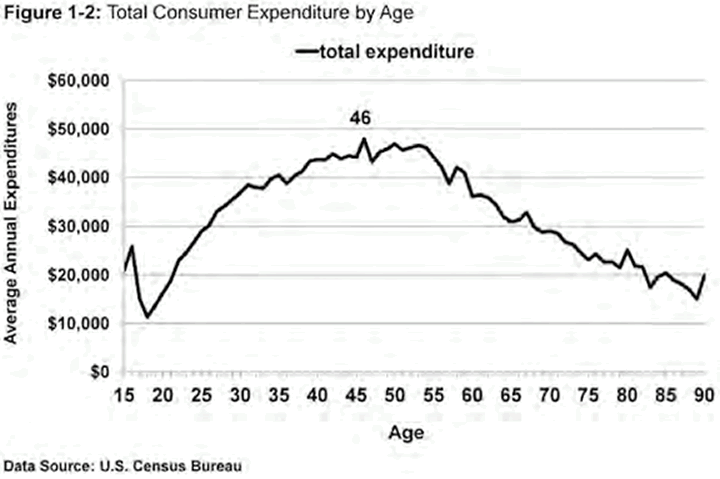
If you want to reduce middle-class economies down to one important factor, this is it: consumer spending by age. Most economists assume consumers are more like a constant and that business and government swings drive our economy. In fact, consumers are 70 percent of the GDP, and business investment only expands if consumer spending is growing and the government taxes businesses and consumers for its revenues; hence, it follows consumer spending indirectly as well.
The difference in spending patterns between a nineteen‐year‐old, a forty‐six‐year‐old, and a seventy‐five‐year‐old is huge. How much did you earn and spend yourself at age eighteen or nineteen? How much did you earn and spend when you bought your largest house and then furnished it in the years to follow? How much do seventy‐five‐year‐olds spend . . . and do they borrow money? Consumers are anything but a constant when generational cycles are shifting the age concentrations significantly—especially the unusually large generations like the Baby Boomers. Note that some individual spending sectors can be very volatile, such as in acquiring items like motorcycles, which are largely purchased during the male midlife crisis years between forty‐five and forty‐nine, or RVs (recreational vehicles) that are largely bought between age fifty‐three and sixty.
In the big picture, what makes this consumer spending cycle so powerful is the fact that people are born (and immigrate) in clear generational waves. These are the two ways that you become a worker and consumer in a country like the United States—workers represent "supply" of goods and the same people as consumers represent "demand." Hence, new generations drive both as they age into their peak spending years—and that's precisely what causes a broad boom in our economy, which happened from 1942 to 1968 and from 1983 to 2007.
A century ago, immigration was the largest driver in the U.S. economy. New arrivals were the biggest factor in what I call the Henry Ford generation, which powered the economic boom that bubbled into the Roaring Twenties. More recently, we have for two decades predicted that immigration will fall sharply again from 2008 forward, when declining spending by Baby Boomers was also pushing us toward the next great depression between 2008 and 2023. We've seen that happening, with the drop‐off from Mexico especially apparent. Along with declining births since 2007, U.S. population is simply not going to grow as fast as economists forecast by extrapolating past trends.
In the recent immigration surge from the 1970s into the 2000s, which peaked in 1991, the immigrants added more to the Baby Boom generation (born from 1934 to 1961) than to the Echo Boom (born from 1976 to 2007) to follow. The highest numbers of immigrants arrive around age twenty‐three (what is called the mode in statistics), with the average age at thirty. The new arrival usually enters the workforce and starts producing and consuming. Hence, immigration has an immediate impact on the economy, unlike new births (the latter arrivals require eighteen to twenty‐two years to enter the workforce and become productive).
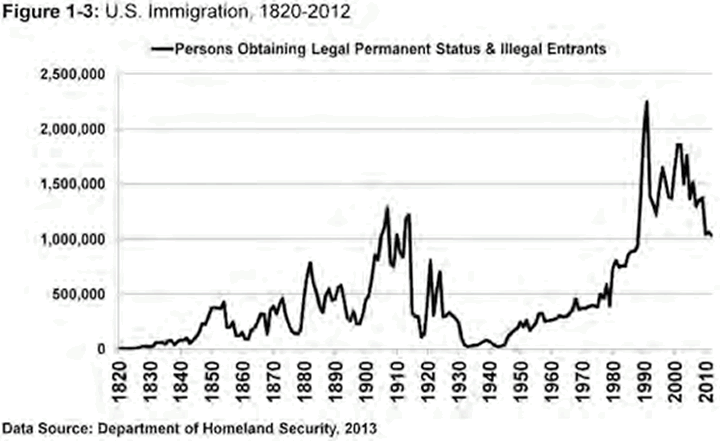
Looking back to the late 1800s, you can see that immigration is anything but constant. There were two major peaks in immigration: the first in 1907 with a major drop-off after 1914; the second was around 1991 with a major drop-off beginning after 2008. Note that immigration dropped to near zero in the 1930s after the greatest surge in American history.
When my outlandish forecasts back in the late 1980s for a Dow of 10,000 by 2000 started to look a bit too conservative, I realized that I wasn't adjusting for immigrants, which I did in 1996. I developed a bell curve for the age of immigrants over decades of data using a computer model to determine when immigrants were actually born on average so I could add them to the birth index as if they were born here. And at Dent Research we make our own future forecasts for immigration taking into account the business cycle instead of the normal straight‐line projections of economists.
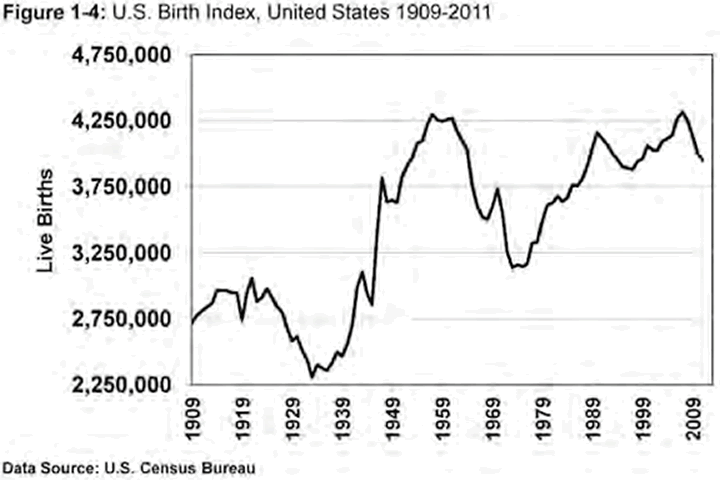
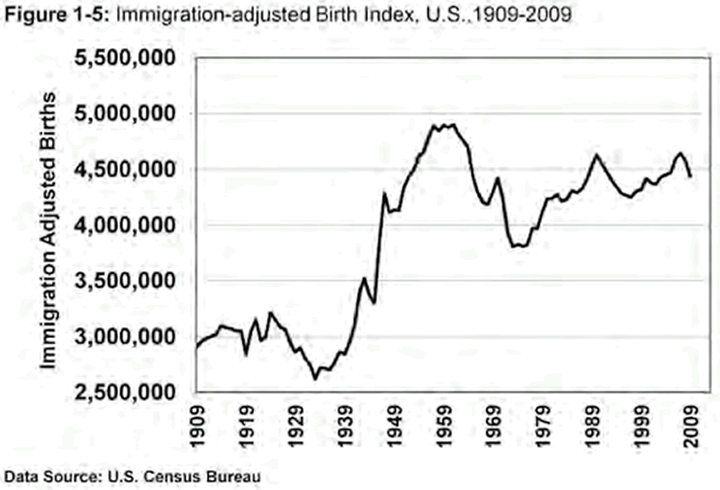
Note how much larger the Baby Boom was than the Bob Hope generation before it. The Echo Boom hit similar levels of births at its peak in 2007. But the last is a smaller wave as a generation, and from 2008 into the early 2020s, births are going to tend to fall more than rise due to a bad economy, just as they did in the 1930s and the 1970s. Note that it's also necessary to adjust the birth index for immigrants to get the total size of each generation. When legal and illegal immigration during the Baby Boom generation is added, the Baby Boom towers higher still.
We found that, when adjusted for immigrants, the Echo Boom generation never reaches the growth numbers of the Baby Boom generation. Hence, it is the first generation to be smaller than the one before it. This pattern is consistent throughout the developed world, with the exception of Australia and the Scandinavian countries. Many European and East Asian countries have no Echo Boom generation at all.
Not everyone recognizes the subtleties of this. In print and broadcast journalism—a May 2013 article in Barron's, for example, and on air at CNBC—we're told that the millennial or Echo Boom generation is larger than the Baby Boom generation. By habit, I cringe when I hear broad statements concerning demographics (too often the speaker hasn't done in‐depth research and reaches wrong conclusions). In this case, the statement is partly true, partly not.
The easy part—and the one that economists usually get right about demographics—is that the populations of most developed countries are aging and that rising entitlement burdens will fall on the younger generations. How will the lower spending and earnings levels of a smaller generation affect the economy? Take a good look at the Japanese economy, which went into a coma after Japan fell off the Demographic Cliff between 1989 and 1996: Japan has had zero inflation and GDP growth for the last two decades (see chapter 2).
Taking a close look at the data, it's clear that the Echo Boom generation does exceed the Baby Boom generation in sheer numbers. In the United States, the birth rate for the Echo Boom group started at a higher level, and its rising birth span of thirty‐two years (1976–2007) was longer than that of the Baby Boom group, at twenty‐eight years (1934–61), as Figure 1‐6 shows. Baby Boomers total 108.5 million adjusted for immigration, compared with 138.4 million Echo Boomers. But the more important point from my research: the peak immigration‐adjusted births of the Baby Boom generation are still substantially higher and have a bigger overall wave.
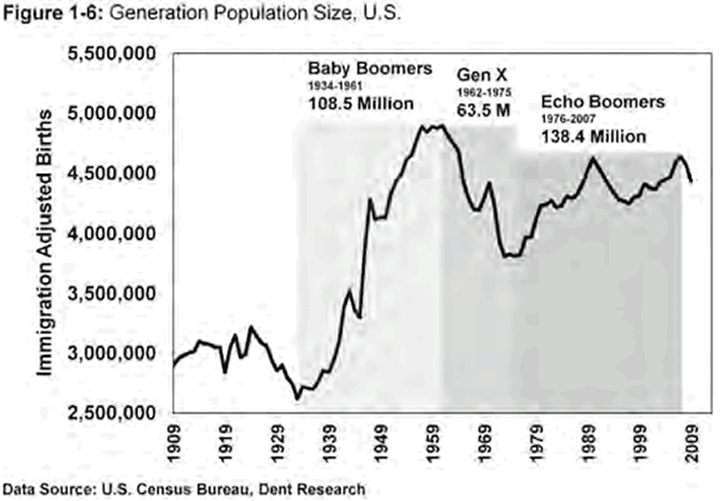
The key to demographic trends and forecasting is reading the wave—namely, the rising wave of births and growth—and distinguishing the relative size of the acceleration of each generation. The Baby Boom is like a ten-foot-tall wave coming onto the beach, whereas the Echo Boom is a five-foot-tall wave. A surfer can instantly tell you the difference! Although the Echo Boom wave is wider in its scope, the Baby Boom wave is taller and greater in magnitude and peak numbers.
In the next boom, from about 2023 forward, the number of households needed to keep the economy going by spending and borrowing money, buying homes, investing, and other economic activity simply will not grow as fast or to the same levels. Yes, many (but not all) developed countries will experience a boom driven by demographics about a decade from now, but it will not be as strong as that precipitated by the rising spending and borrowing of the Baby Boomers.
Growth is more likely to come as a result of technological advances, especially those that will increase longevity and working years, which could help compensate for the lower number of workers. Such areas as biotechnology, robotics, nanotechnology, and new energy sources that are cleaner will be the drivers, but it will be a long time before they affect the economy broadly, because it takes decades for new innovations to gain momentum. For example, the automobile was invented in 1886, but only began to move into the mainstream U.S. economy from 1914 to 1928.
Harry Dent's new book, The Demographic Cliff: How to Survive and Prosper During the Great Deflation of 2014-2019, is available here.
And here again is the conversation between Harry Dent and John Mauldin, moderated by Ed D'Agostino.
John Mauldin
subscribers@MauldinEconomics.com
Like Outside the Box?
Sign up today and get each new issue delivered free to your inbox.
It's your opportunity to get the news John Mauldin thinks matters most to your finances.
© 2013 Mauldin Economics. All Rights Reserved.
Outside the Box is a free weekly economic e-letter by best-selling author and renowned financial expert, John Mauldin. You can learn more and get your free subscription by visiting www.MauldinEconomics.com.
Please write to subscribers@mauldineconomics.com to inform us of any reproductions, including when and where copy will be reproduced. You must keep the letter intact, from introduction to disclaimers. If you would like to quote brief portions only, please reference www.MauldinEconomics.com.
To subscribe to John Mauldin's e-letter, please click here: http://www.mauldineconomics.com/subscribe
To change your email address, please click here: http://www.mauldineconomics.com/change-address
Outside the Box and MauldinEconomics.com is not an offering for any investment. It represents only the opinions of John Mauldin and those that he interviews. Any views expressed are provided for information purposes only and should not be construed in any way as an offer, an endorsement, or inducement to invest and is not in any way a testimony of, or associated with, Mauldin's other firms. John Mauldin is the Chairman of Mauldin Economics, LLC. He also is the President of Millennium Wave Advisors, LLC (MWA) which is an investment advisory firm registered with multiple states, President and registered representative of Millennium Wave Securities, LLC, (MWS) member FINRA, SIPC, through which securities may be offered . MWS is also a Commodity Pool Operator (CPO) and a Commodity Trading Advisor (CTA) registered with the CFTC, as well as an Introducing Broker (IB) and NFA Member. Millennium Wave Investments is a dba of MWA LLC and MWS LLC. This message may contain information that is confidential or privileged and is intended only for the individual or entity named above and does not constitute an offer for or advice about any alternative investment product. Such advice can only be made when accompanied by a prospectus or similar offering document. Past performance is not indicative of future performance. Please make sure to review important disclosures at the end of each article. Mauldin companies may have a marketing relationship with products and services mentioned in this letter for a fee.
Note: Joining The Mauldin Circle is not an offering for any investment. It represents only the opinions of John Mauldin and Millennium Wave Investments. It is intended solely for investors who have registered with Millennium Wave Investments and its partners at http://www.MauldinCircle.com (formerly AccreditedInvestor.ws) or directly related websites. The Mauldin Circle may send out material that is provided on a confidential basis, and subscribers to the Mauldin Circle are not to send this letter to anyone other than their professional investment counselors. Investors should discuss any investment with their personal investment counsel. You are advised to discuss with your financial advisers your investment options and whether any investment is suitable for your specific needs prior to making any investments. John Mauldin is the President of Millennium Wave Advisors, LLC (MWA), which is an investment advisory firm registered with multiple states. John Mauldin is a registered representative of Millennium Wave Securities, LLC, (MWS), an FINRA registered broker-dealer. MWS is also a Commodity Pool Operator (CPO) and a Commodity Trading Advisor (CTA) registered with the CFTC, as well as an Introducing Broker (IB). Millennium Wave Investments is a dba of MWA LLC and MWS LLC. Millennium Wave Investments cooperates in the consulting on and marketing of private and non-private investment offerings with other independent firms such as Altegris Investments; Capital Management Group; Absolute Return Partners, LLP; Fynn Capital; Nicola Wealth Management; and Plexus Asset Management. Investment offerings recommended by Mauldin may pay a portion of their fees to these independent firms, who will share 1/3 of those fees with MWS and thus with Mauldin. Any views expressed herein are provided for information purposes only and should not be construed in any way as an offer, an endorsement, or inducement to invest with any CTA, fund, or program mentioned here or elsewhere. Before seeking any advisor's services or making an investment in a fund, investors must read and examine thoroughly the respective disclosure document or offering memorandum. Since these firms and Mauldin receive fees from the funds they recommend/market, they only recommend/market products with which they have been able to negotiate fee arrangements.
PAST RESULTS ARE NOT INDICATIVE OF FUTURE RESULTS. THERE IS RISK OF LOSS AS WELL AS THE OPPORTUNITY FOR GAIN WHEN INVESTING IN MANAGED FUNDS. WHEN CONSIDERING ALTERNATIVE INVESTMENTS, INCLUDING HEDGE FUNDS, YOU SHOULD CONSIDER VARIOUS RISKS INCLUDING THE FACT THAT SOME PRODUCTS: OFTEN ENGAGE IN LEVERAGING AND OTHER SPECULATIVE INVESTMENT PRACTICES THAT MAY INCREASE THE RISK OF INVESTMENT LOSS, CAN BE ILLIQUID, ARE NOT REQUIRED TO PROVIDE PERIODIC PRICING OR VALUATION INFORMATION TO INVESTORS, MAY INVOLVE COMPLEX TAX STRUCTURES AND DELAYS IN DISTRIBUTING IMPORTANT TAX INFORMATION, ARE NOT SUBJECT TO THE SAME REGULATORY REQUIREMENTS AS MUTUAL FUNDS, OFTEN CHARGE HIGH FEES, AND IN MANY CASES THE UNDERLYING INVESTMENTS ARE NOT TRANSPARENT AND ARE KNOWN ONLY TO THE INVESTMENT MANAGER. Alternative investment performance can be volatile. An investor could lose all or a substantial amount of his or her investment. Often, alternative investment fund and account managers have total trading authority over their funds or accounts; the use of a single advisor applying generally similar trading programs could mean lack of diversification and, consequently, higher risk. There is often no secondary market for an investor’s interest in alternative investments, and none is expected to develop.
John Mauldin Archive |
© 2005-2022 http://www.MarketOracle.co.uk - The Market Oracle is a FREE Daily Financial Markets Analysis & Forecasting online publication.




